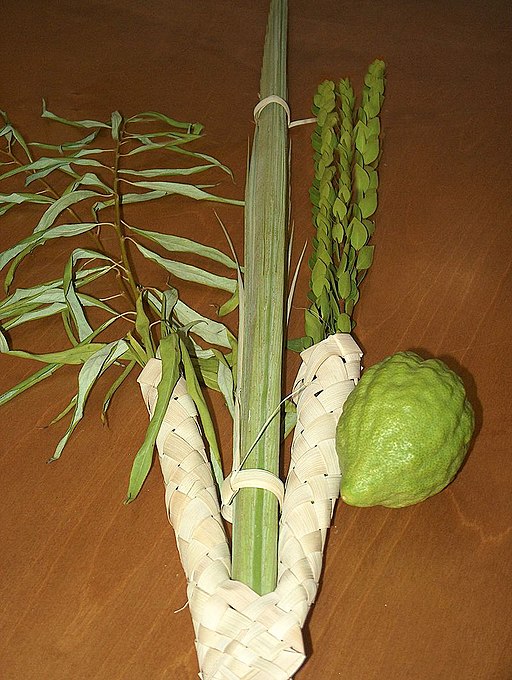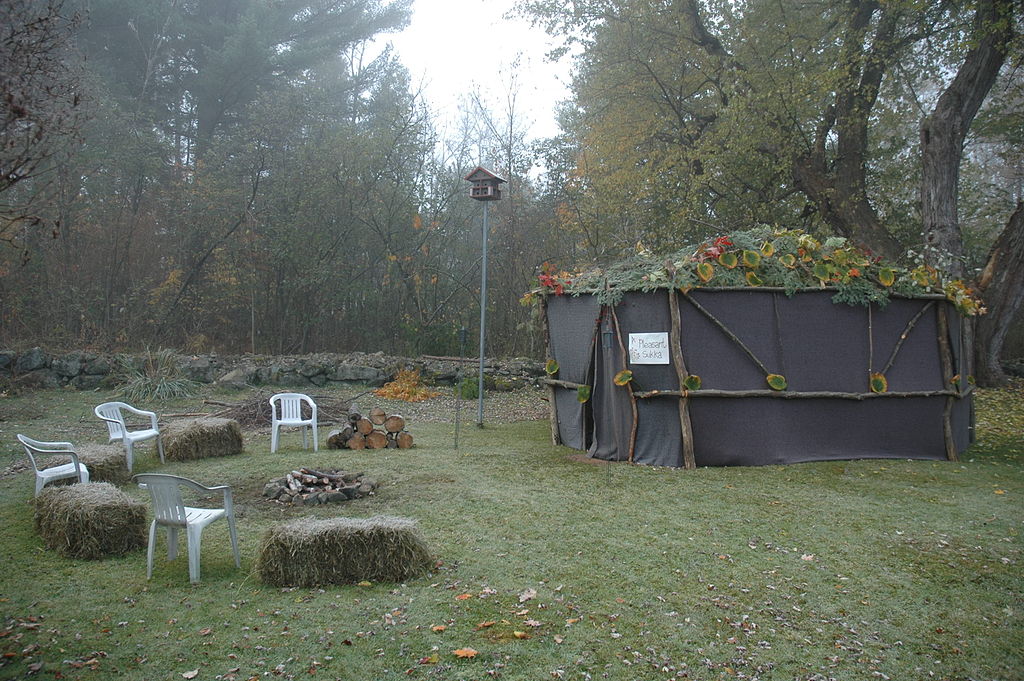Four species.
The number seven.
And a word called ushpizin.
Welcome to Sukkot, the holiday of many names.
- What is Sukkot?
- What does Sukkot mean?
- What are the origins of Sukkot?
- How do you celebrate Sukkot? What are the rituals and traditions of Sukkot?
- When is Sukkot?
What is Sukkot?
Sukkot is a weeklong biblical Jewish holiday, celebrated on the 15th day of Tishrei (that is, the 15th day of the seventh month of the Hebrew calendar). So that is 15 days after Rosh Hashanah (the Jewish New Year) and 5 days after Yom Kippur. Usually it means that it is celebrated during September or October.
Sukkot celebrates the end of the harvest time and commemorates the Exodus of the Hebrews from Egypt.
During the existence of the Temple in Jerusalem, the holiday was one of the Three Pilgrimage Festivals. The Three Pilgrimage Festivals are three major festivals in Judaism (Passover, Shavuot, and Sukkot), when the ancient Israelites living in the Kingdom of Judah would make a pilgrimage to the Temple in Jerusalem, as commanded by the Torah.
What does Sukkot mean?
Sukkot is plural of the Hebrew word Sukkah – basically a temporary booth or hut.
A sukkah must have three walls, should be at least three feet tall, and be positioned so that at least part of its roof is open to the sky. The sukkah is topped with plant material (the “roof” is called s’chach, and is usually made from palm leaves), and is often decorated with autumnal, harvest or Judaic themes.
The significance of the holiday is twofold.
The first is agricultural – it marks the end of the harvest time (and thus the end of the agricultural year) in the Land of Israel.
During harvesting, the farmers would live in temporary accommodations called sukkah. Hence, the agricultural significance of the holiday.
The second is religious and historic – commemorating the Exodus of the Hebrews from Egypt and the dependence of the People of Israel on the will and protection of God.
After the Israelites fled slavery in Egypt, they travelled for 40 years in the desert until they reached the Land of Israel. During this time, the Israelites lived in temporary and fragile dwellings. The sukkah is a reminiscence of these dwellings.

What are the origins of Sukkot?
As we mentioned, Sukkot has two meanings – agricultural and religious-historic. So I bet it won’t come as a surprise that each of the meanings of the holiday has its own origin.
The agricultural origin appears in the book of Exodus, which is the second book of the Hebrew Bible. In Exodus 23:16, it says:
“You shall observe the festival of harvest, of the first fruits of your labor, of what you sow in the field. You shall observe the festival of ingathering at the end of the year, when you gather in from the field the fruit of your labor.”
That is why Sukkot is also known as the Festival of Ingathering or Harvest Festival.
The religious-historic origin appears in the book of Leviticus, which is the third book of the Hebrew Bible. In Leviticus 23:33-43, it says:
“The Lord spoke to Moses, saying: Speak to the people of Israel, saying: On the fifteenth day of this seventh month, and lasting seven days, there shall be the festival of booths[e] to the Lord… so that your generations may know that I made the people of Israel live in booths when I brought them out of the land of Egypt: I am the Lord your God.”
How do you celebrate Sukkot? What are the rituals and traditions of Sukkot?
Sukkot is a very long holiday – 7 days long.
The first day is like Shabbat – there are special prayer services as well as holiday meals. And like on Shabbat, candles are lit in the evening and Kiddush precedes the festive meals (which include the delicious challa). Work is prohibited on this day.
The seventh day of Sukkot is called Hoshana Rabbah (Hebrew for Great Supplication). This day is marked by a special synagogue service – worshippers holding the four species make seven circuits while the congregation recites Hoshanot (liturgical poems). The rituals of Hoshana Rabbah are reminiscent of the practices that existed in the times of the Holy Temple in Jerusalem, which is kind of cool when you think about it.

The days in between the first and seventh days are festival weekdays (in Hebrew: “Chol Hamoed”), during which some types of work are forbidden.
Throughout the week of Sukkot, all of the meals are eaten in the sukkah. Every day (except for Shabbat), observant Jews take the four species (also known as Four Kinds) and recite a blessing over them. Then, they bring them together and wave them right, left, forward, up, down and backward.
Another custom is to recite a prayer called ushpizin prayer to “invite” one of seven “exalted guests” into the sukkah (the word “ushpizin” means guests).
These guests that are invited represent the “seven shepherds of Israel”: Abraham, Isaac, Jacob, Moses, Aaron, Joseph and David,
So what are the four species/four kinds, which are blessed and waved?
Well, the four species are four plants mentioned in the Torah.
Leviticus 23:40 says:
“And you shall take on the first day the fruit of splendid trees, branches of palm trees and boughs of leafy trees and willows of the brook, and you shall rejoice before the LORD your God for seven days.”
Observant Jews tie together three types of branches and one type of fruit and wave them in a special ceremony each day of the Sukkot holiday, excluding Shabbat.
The four plants are identified as:
Etrog, the fruit of a citron tree.
Lulav, a ripe, green, closed frond from a date palm tree
Hadass, boughs with leaves from the myrtle tree
Aravah, branches with leaves from the willow tree
The holiday immediately following Sukkot is known as Shemini Atzeret, which is Hebrew for Eighth [Day] of Assembly.
On Shemini Atzeret most people stay in the sukkah and eat their meals there, but do not bless over the four species (to differentiate this holiday from Sukkot).
Due to the agricultural significance of the holiday, on this day the Jews pray for rain.

In the Diaspora a second additional holiday called Simchat Torah (“Joy of the Torah”) is celebrated, but in the Land of Israel it is unified with Shemini Atzeret.
During Simchat Torah, Jews celebrate the conclusion of the cycle of reading from the Torah (the Hebrew Bible). Just as plants have their cycles, so does the reading of the Torah. And when a cycle ends, it is time to celbrate and rejoice with… circles! See, not only the food is symbolic on Jewish holidays.
On this day, Jews march and dance with Torah scrolls around the reading table in the synagogue, in a custom called Hakafot (Hebrew for “to go around” / “do laps”).
Can you guess how many laps around the reading table take place?
That’s right. Seven. Just as the intro suggested 😉
So there you have it! Pretty much all you need to know about the holiday of Sukkot aka Festival of Ingathering aka Harvest Festival aka Feast of Booths (or Tabernacles).
When is Sukkot?
2021 – begins in the evening of Monday, 20 September and ends in the evening of Monday, 27 September
2022 – begins in the evening of Sunday, 9 October and ends in the evening of Sunday, 16 October
2023 – begins in the evening of Friday, 29 September and ends in the evening of Friday, 6 October
2024 – begins in the evening of Wednesday, 16 October and ends in the evening of Wednesday, 23 October
2025 – begins in the evening of Monday, 6 October and ends in the evening of Monday, 13 October

